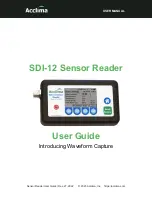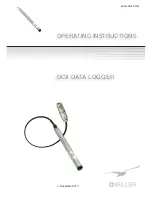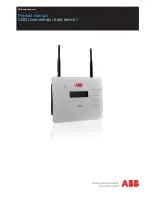
NOVUS AUTOMATION
1/7
LogBox-DA
ELECTRONIC DATA LOGGER - MANUAL V1.1x H
PRESENTATION
LogBox-DA
is an electronic data logger with two input channels, one
analog and one digital. Input data
is stored in the logger internal
memory, for later download to a PC for visualization and analysis in
the form of tables or graphs. The data is easily exported
to
spreadsheets.
The
LogChart-II
is the software used to configure the logger,
download and visualize data. The logger configuration allows
defining the logger operation mode, including programming the
start/stop time of data acquisition. Other parameters such as signal
input type, logging interval, multiplication factor, scale range, etc, are
easily selected through the
LogChart-II
software.
The
LogBox-DA
also provides a signal for commanding an external
power supply (battery) of a device connected to the logger. This
feature allows that external devices, such as a transmitter, be
powered only during the measurement sample time, thus extending
the autonomy of these external batteries.
MEMORY CAPACITY
•
64k Model: Allows up to 64,000 records
Memory capacity is always shared between enabled channels. In
case there are two channels enabled, each gets 50 percent of the
memory available. When only a single channel is enabled, it has the
entire memory at its disposal.
Memory capacity is indicated on the identification label placed on the
logger case.
Example:
Fig. 1
– Lateral identification label
INPUT SIGNALS
Channel 1 (IN 1) counts electric pulse signals. They can be voltage
pulses, a dry contact (switch) or open collector signals, as selected in
the configuration.
Channel 2 (IN 2) measures linear analog signals, which can be 0-
20mA, 4-20mA, 0-50mV or 0-5V, user defined.
Note: For the channel 2, depending on the input signal selected, it
may be necessary to configure an internal jumper.
DATA ACQUISITION (LOGGING)
Data can be acquired by means of two different modes.
In channel 1, which counts pulses, the number of input pulses
counted in the logging time interval is stored in the logger memory at
the end of the interval. The maximum number of loggings that can be
stored depends on the memory capacity of the device model.
In channel 2, specific for analog signals, the logger can be configured
to perform a single measurement at the end of the selected time
interval storing the value read; 10 measurements within the time
interval and store the mean of values read, or, yet, record the
minimum or maximum values read in the interval.
OPERATION
The logger operation mode is user-defined in the
LogChart-II
software
.
To access or change this configuration, the
IR-LINK3
interface is required
.
The user must
install the LogChart-II software in
a computer and run the logger configuration according to instructions
defined in the LogChart-II installation section of this manual.
After configuration and input electric connections made, the device is
ready to measure and log input signals. The status indicators show
the logger current status.
STATUS INDICATORS (LEDS)
The Status Indicators (see
Fig. 2
) are located in the logger front
panel. They indicate the current working conditions of the unit.
LOG Indicator (
Logging)
:
While in stand-by (not logging) or after
a series of acquisitions is ended, it flashes once at every four
seconds. While logging is active, it flashes twice every four
seconds.
ALM Indicator (
alarm
):
Alerts the user regarding alarm conditions.
Once triggered, the alarm LED keeps flashing once at every four
seconds until a new configuration is entered.
Fig. 2
– LED Indicators and IR communication

























